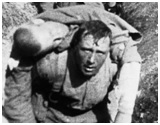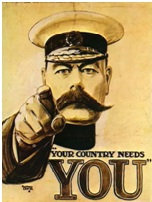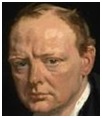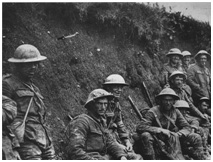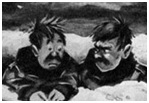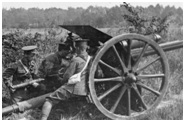|
 |
|
 |
|
|
||
The Battle of the Somme - Leadership and Strategy
The Battle of the Somme (July – November 1916)
Famous for... 1.The British army’s most disastrous day ever On the first day of the battle (1st July 1916) the British had 57,470 casualties including 19,240 killed (see right a photograph from the 1916 film, Battle of the Somme) . Casualties for the whole battle (that ended on 18th November) were:
It was one of the bloodiest battles in the First World War, along with:
2. “Your Country Needs You” This was the British Secretary of War, Lord Kitchener’s famous slogan (pictured right) on his army recruitment poster (pictured right). Thousands joined up to create “Kitchener’s New Army”. They were organized into ‘pals’ battalions’ (with people from the same town, factory or occupation in the same battalion). The Somme was these volunteers’ first battle.
3.The first use of the tank in battle The tank was introduced by the British on September 15th (pictured right). It was initially successful but then hit by mechanical breakdowns.
Why did the First World War start in 1914?
1. Archduke Ferdinand (heir to the Austrian throne, pictured right) Ferdinand was killed by Serbians in Sarajevo, Bosnia.
2. Russia (and its allies) (led by Tsar Nicholas II, pictured right in 1912) Russia supported the Serbians, helped by its allies, France and Britain.
3. Germany (led by Kaiser Wilhelm, pictured right) Germany supported Austria-Hungary.
The two sides in the war
Britain was bravely assisted by its empire including:
2. Germany and Austria-Hungary (joined by Turkey). The Englishman, T. E. Lawrence, pictured right (made famous by the film, Lawrence of Arabia) successfully led the Arabs against the Turks in the Middle East. Most of the other fighting occurred in France on the Western Front.
Why was it called the Battle of the Somme? It happened near the River Somme in north-eastern France, 80 miles south of Dunkirk British troops were evacuated from Dunkirk in 1940 to escape the advancing German army in the Second World War.
Why was the battle important? 1. The Battle of Gallipoli (1915) This terrible defeat resulted from Winston Churchill’s (pictured right in 1916) disastrous plan to invade Turkey through the Dardenelles, a narrow strip of sea leading to the Black Sea. This meant that:
2. The Battle of Verdun (1916) The Battle of the Somme diverted German troops away from their attack on Verdun, a French fortress.
The opposing armies at the Somme Initially the numbers were:
Extra troops were added during the battle. Who were the army commander-in-chiefs?
Trench warfare In the battle British and French trenches (pictured right below on the first day of the battle) were:
Three trenches were built in parallel:
Why was the Germans’ defence much better? They built a set of trenches around 3,000 metres behind the first trench. German dugouts were:
How did they fight? 1. Infantry (pictured right is a German soldier at the battle) Soldiers went ‘over the top’. This was the British troops' phrase to describe advancing with their rifles from the front trench into ‘no man’s land’. This was the land between the opponents’ trenches (where British and German soldiers famously played football during a truce on Christmas Day 1914). Machine guns were used in defence (another reason for the huge casualties).
2. Artillery (big guns) This was used to:
3. Air force (Britain’s was then called the Royal Flying Corps) (for enemy reconnaissance).
What was it like to fight? Horrible! Apart from the constant threat of death and enemy shell fire, the soldiers’ biggest enemies were:
Officers lived in dugouts but many soldiers had to live in muddy trenches stinking of excrement. Their only comforts were:
Morale was also boosted by:
The cartoon (pictured right) shows Bill telling a grumbling soldier in one shell hole to: “Well, if you knows of a better ‘ole, go to it”.
The soldiers had no choice but to fight and desertions were very rare. Only 306 British and empire soldiers were shot for cowardice and desertion.
A poet’s perspective In March 1919 the English poet and soldier, Siegfried Sassoon (pictured right in 1915) wrote about the battle’s horrors in his poem, Aftermath (Mamitz was a French village captured by the British):
Do you remember the dark months you held the sector at Mamitz - The nights you watched and wired and dug and piled sandbags on parapets? Do you remember the rats; and the stench Of corpses rotting in front of the front-line trench – And dawn coming, dirty-white and chill with a homeless rain? Do you ever stop and ask, ‘Is it all going to happen again?
Key events of the Battle of the Somme
24-30 June Seven days of:
The noise was deafening and could be heard in London. The British army chief, Douglas Haig’s (pictured right in 1917) plan was to weaken the enemy for a major offensive. But the Germans were largely untouched (including their barbed wire) due to:
1st July The battle begins at 7.30 am. British troops were:
18 November The battle ends with both sides exhausted and mutilated.
Was Douglas Haig to blame? It is easy to blame him for the carnage “Lions led by donkeys” has been a common phrase used against him. Haig was vilified in the:
Criticisms of Haig's leadership
1. Lack of imagination Haig couldn’t come up with an alternative to slugging it out in the trenches. Perhaps (tragically) there wasn't one.
2. Ineffectiveness He didn’t achieve any of his aims - to:
3. Battle tactics Haig:
4. Control of his deputies General Henry Rawlinson (pictured right in 1916):
5. Poor troop training The military training of the civilian volunteers could have been much better. Training (particularly in artillery support for infantry) made Britain's 18th Division (led by Major-General Maxse, pictured right) the best infantry division.
6. Inadequate artillery (pictured right) Haig:
Why is Haig now admired by historians?
1. Unlucky Haig was hindered by things outside his control:
2. Morale booster The battle significantly dented the German morale (from which they never really recovered)
3. Character Haig had great determination and integrity.
4. Learning Haig achieved victory in 1918 after learning from his mistakes in 1916 and 1917.
Results of the battle
1. Horrific casualties Over a million casualties on both sides.
2. Bravery Soldiers’ bravery was astonishing, bearing in mind the hell they were in.
3. Demoralization The battle convinced everyone of the horror of war and particularly demoralized the Germans, leading to their eventual defeat in 1918.
4. Learning The lessons from the battle (particularly support for infantry by artillery):
Results of the First World War
1. Diabolical deaths
2. Treaty of Versailles (1918) The peace treaty forced Germany to pay huge war reparations (against the advice of the British economist, John Maynard Keynes, ,pictured right). Keynes said the economic and social effects of this debt would be disastrous (see point 3).
3. Hitler and the Second World War The Germans were humiliated and couldn’t pay the war reparations, leading to
So they elected Adolf Hitler (pictured right) and his Nazi party to restore national pride and prosperity.
4. Russian Revolution (1917) Russia’s disastrous war weakened Tsar Nicholas’ government, giving the Bolshevik communists (led by Lenin, pictured right) the opportunity to overthrow him.
5.The end of empire The war helped the disintegration of the four European empires (Austrian, British, French and German).
6. Social revolution People were disillusioned and wanted to forget the war. This led to the fun loving (for the rich anyway) Roaring Twenties until... Unemployment and poverty soared during the Great Depression, caused by the Wall Street Crash of 1929. In Britain women (30 and over) got the vote in 1918, because they did useful wartime jobs. The British nurse, Edith Cavell, pictured right, was executed for heroically helping British and French prisoners escape from German occupied Belgium.
Key quotes
The Somme marked the end of an age of vital optimism in British life that has never been recovered, - John Keegan, British military historian, pictured right (from his 1998 book, The First World War). The war that will end all war. - H. G. Wells (English novelist, pictured right, talking about the First World War).
It is in the great battles of 1916 and 1917 that we have to seek the secret of our victory in 1918, - Douglas Haig (on learning from his mistakes).
Words cannot express the horrors of it all, - Captain Rex Gee (Durham Light Infantry) talking about the first day of the Battle of the Somme.
I wasn't frightened. I was bloody petrified. - Private Donald Cameron (York and Lancaster Regiment) How did we get through? Partly the fear of fear. The fear of being found afraid. Another factor is the belief in human beings - your colleagues. - Second Lieutenant Edmund Blunden (Royal Sussex Regiment, pictured right)
Brilliant to the top of his army boots. - David Lloyd George (pictured right), the British prime minister 1916-22. (his description of Douglas Haig)
The Somme is like the Holocaust. It revealed things about mankind that we cannot come to terms with and cannot forget. It can never become the past, - Pat Barker (pictured right) English novelist.
All feelings of humanity leave you when you're fighting. You say to yourself, well, it's either him or me, - Archie Richards, a British member of the tank corps at the battle.
Best books John Keegan, The First World War (1998) Fiona Reynoldson, War Beyond Britain (1987).
|
|
|
||
|
|
||
| Copyright © wisdomtowin.com 2025 All Rights Reserved | ||
|


